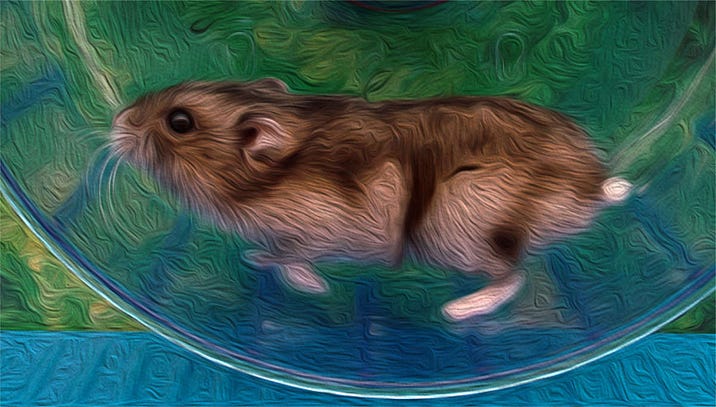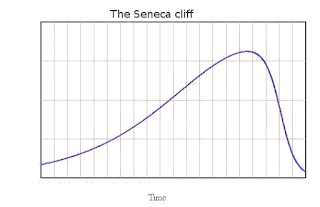The Great Pause Week 99: Hamster Wheel Futures
"Cultural inertia is what binds us to outdated memes."
A few years ago Rob Hopkins, best known for his work in creating the post-apocalyptic Transition Network, came out with a book, From What Is to What If, lamenting our collective failure of imagination. Why, he asked, have we been so reluctant to break free of millennial memes of hierarchical, hostile, unsustainably extractive and self-destructive social patterns? Why could we not simply imagine something better and then do it? He decided that it was a failure of imagination more than other barriers, and that imagination was like a muscle that either you exercise or it atrophies. As a global culture we tend to relegate creative imagining to the artistic periphery.
“Reproductive futurity” is how Alex Cuicho described the rut that our mainstream finds itself in.
Under reproductive futurity, we are collectively biased towards non-disruptive and incremental change, and against the radical, queer, or truly revolutionary that threatens the so-called “natural order” of biological sex, family values, and economic growth. So-called realism has trapped us in an interminable present, where even the most daring innovations fail to envision a better and more equitable world — and in fact depend on the failure of our imagination for their successes….
He cites the Amazon business model that optimizes customer experience at the expense of employee welfare or the trials and tribulations of tech pioneers like Elon Musk who try to push the boundaries only to discover that boundaries push back.
In psychology this is called normalcy bias. To some extent it involves optimism bias and mind-over-reality denialism, but as we progress into the Anthropocene more of us will see, and sooner or later have to acknowledge, the likelihood of a very different future. Wildfires, floods, hurricanes and plagues will dim our utopian hopes. The inertia of normalcy will be broken. A new stable paradigm will need to emerge.
Why do we insist on perpetuating the status quo despite the clear impossibility of that? Cuicho quotes the artist Sin Wai Kin (fka Victoria Sin), “How do we envision a future that isn’t a way forward, but a way down?” Actually, Sin, it’s a whole literary genre already, and one that Hopkins has been adding to for more than two decades, since the publication of the Kinsale Energy Descent Action Plan. You can trace it back at least as far as Howard and Elizabeth Odum’s A Prosperous Way Down, written in 1980, or the Club of Rome report, Limits to Growth, in 1972. Ugo Bardi reminds us of the Roman Senator Lucius Anneaus Seneca (4 BCE-65 CE) who said “Increases are of sluggish growth but the way to ruin is rapid.”
I visited St. Petersburg in the early 1990s, when Russia was experiencing a much harder crash than anything being threatened now in Cold War Deux at the Ukrainian border. People were destitute and desperate but families had dachas on the outskirts of the city that grew four season crops of beets, berries, and barleycorn. There was food security, housing security (the government suspended evictions and dispossessions), and relative personal security (no one had guns except the military and the mafia). What I witnessed was an inertia of possessions, education, professions and culture that carried the population through until stability could be restored. The ballet still danced. People went to work even if they weren’t paid. You could still gather with your friends over vodka and card games at the banya (neighborhood sauna) every Saturday night. Life went on, poorer, but adequate. Something very similar was seen in Cuba during the “Special Period.” Cuba is in its seventh decade of punitive sanctions for the unpardonable sin of overthrowing a Chaplinesque puppet dictator. Haiti is in its third century of sanctions for a similar offense. Sanctions today are more likely to hurt sanctioners than the sanctioned.
Cultural inertia is what binds us to outdated memes — ideas that have lost their utility and relevance to the present moment: colonialism; the Cold War; “natural” enemies; inferior tribes that we can exploit with moral rectitude. I had a discussion recently with some friends in Russia about homophobia. It began:
Apropos of discussing all sorts of issues, lately I am struck by random slurs against homosexuals and trans people coming from some of my friends, generally tossed out as some agreed sign of decadence in the West. Of course, my Chinese friends have similar views, as do some Latin cultures, like Cuba, and also many African cultures.
One Russian participant replied:
From Russia it looks like an overall suicidal schizophrenic depressive gender dysphoric biological extinction track that your culture is on. It is part of what the feminist Camille Paglia (author of Sexual Personae) tagged as a telltale sign of culture death. It is most distressing to watch even from far away. Your society is sick and dying. Trying to infect Russia with this sickness may cause it to die sooner. I suggest leaving this subject well alone. Sorry to be so harsh, but what’s at stake is biological survival, which is mighty important. 100% of existing plant and animal species would agree.
I would characterize this as the traditionalist response — gender is settled, it is dipolar, as in plants, and anything else is an aberration — but the response is good because it brought up culture death and the conflict between biological survival and cultural inertia. The difficulty I have is that much of the science underpinning the traditionalist response is outdated. It is a busted meme. Where homosexuality is concerned, anti-gay philosophy somehow missed three decades of advances in evolutionary biology. neuroscience, genetics, and phylogeny.
By way of example is this from a peer-reviewed journal article in 2009:
During the intrauterine period the fetal brain develops in the male direction through a direct action of testosterone on the developing nerve cells, or in the female direction through the absence of this hormone surge. In this way, our gender identity (the conviction of belonging to the male or female gender) and sexual orientation are programmed into our brain structures when we are still in the womb. However, since sexual differentiation of the genitals takes place in the first two months of pregnancy and sexual differentiation of the brain starts in the second half of pregnancy, these two processes can be influenced independently, which may result in transsexuality. This also means that in the event of ambiguous sex at birth, the degree of masculinization of the genitals may not reflect the degree of masculinization of the brain.
It seems from what I can find that about 12% of the hormone assignments in the third trimester are not correctly aligned with the genitalia assignments of the first trimester. For unknown reasons this varies greatly by geography and possibly by family line. Many factors may play a role: epigenetics, diet, pharmacological exposure of the mother; environmental toxins that cross the placental barrier, maybe even plastics. Or it could be sampling error. It may also have been different in other centuries. Who knows what was going on in Ancient Greece or Rome?
Let’s accept 12%. That leaves about 88% where the alignment is as would be expected from the physiology of the individual at birth. Within that 12% there also seems to be a gradient of hormonal dissonance. Personally, I would place about 10 different human sexual types along that spectrum. There is no proof that social environment after birth has an effect on gender identity or sexual orientation, but if you are wavering on the sex hormone spectrum, you might be psychologically influenced in one direction or another, I’d assume, based on environment. The spectrum also includes those who may be gender neutral, confused, or ambivalent.
I have Palestinian and Cuban friends who would be aghast we are even having this discussion. In some cultures the 12% on the spectrum would be at risk of beheading. My Russian friends were for the most part pretty liberal or somewhere in the middle, regarding it with their usual wry humor.
Like many around the world they look at the US as a country gone nearly crazy. It is a nation that recently elected, and may soon re-elect, a pathological narcissist and head of a multigenerational crime family as its president. Half of its principal legislative body say they do not believe in climate change. A significant fraction of the population believe that angels and/or aliens are living among us and are here to save the world, or at least the US, from whatever kind of jam we have created. Maybe they’re here to save us from a viral plague of LGBTQ.
What I see in the United States, being outside now and looking in, is not an incipient civil war, but the slow, reluctant death of old memes — racism, homophobia, authoritarianism, self-righteousness, exceptionalism. This is not to say that temes that are lining up to replace the old order — AI, AR, crypto, Meta, identity verification — are any better. They bring their own problems. The Great Pause has given us a chance to think about those things. While some people are determined to keep the old ways going — running one way on the hamster wheel — others are racing in the opposite direction, which causes the wheel to stall.
All great social movements in history were led by art movements of one kind of another. The more enlightened countries are giving artists the space they need to create. Suppose that 12 percent emerging from the womb are queer in an artistic way. They are muscularly imaginative. Our future may depend on them.
_________________________
The COVID-19 pandemic has destroyed lives, livelihoods, and economies. But it has not slowed down climate change, which presents an existential threat to all life, humans included. The warnings could not be stronger: temperatures and fires are breaking records, greenhouse gas levels keep climbing, sea level is rising, and natural disasters are upsizing.
As the world confronts the pandemic and emerges into recovery, there is growing recognition that the recovery must be a pathway to a new carbon economy, one that goes beyond zero emissions and runs the industrial carbon cycle backwards — taking CO2 from the atmosphere and ocean, turning it into coal and oil, and burying it in the ground. The triple bottom line of this new economy is antifragility, regeneration, and resilience.
Help me get my blog posted every week. All Patreon donations and Blogger or Substack subscriptions are needed and welcomed. You are how we make this happen. Your contributions are being made to Global Village Institute, a tax-deductible 501(c)(3) charity. PowerUp! donors on Patreon get an autographed book off each first press run. Please help if you can.
#RestorationGeneration #ReFi #Regenerosity
“There are the good tipping points, the tipping points in public consciousness when it comes to addressing this crisis, and I think we are very close to that.”
— Climate Scientist Michael Mann, January 13, 2021.
______________
Want to help make a difference while you shop in the Amazon app, at no extra cost to you? Simply follow the instructions below to select “Global Village Institute” as your charity and activate AmazonSmile in the app. They’ll donate a portion of your eligible purchases to us.
How it works:
1. Open the Amazon app on your phone
2. Select the main menu (=) & tap on “AmazonSmile” within Programs & Features
3. Select “Global Village Institute” as your charity
4. Follow the on-screen instructions to activate AmazonSmile in the mobile app





Comments